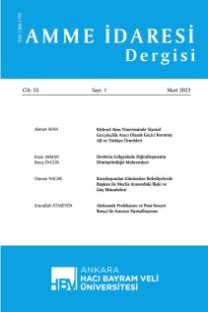Türkiye’de Parti Tercihlerinde Sıradışı İlçelerin Belirlenmesi (2007-2015)
Bu çalışmada parlamenter sistemde yapılan son dört genel seçim (2007, 2011, Haziran 2015 ve Kasım 2015) sonuçlarına göre 9 seçim bölgesinde ve ülke genelinde sıradışı oylama gösteren ilçelerin belirlenmesi amaçlanmıştır. Bunun için her bir seçim bölgesindeki ilçelere ait oy oranları dört siyasal parti (AKP, CHP, MHP, HDP) kategorisinde standart Z puanlarına dönüştürülmüştür. Dönüştürülmüş veride ortalamadan ±2,5 standart sapma uzaklıkta kalan ilçeler sıradışı oylama gösteren ilçeler olarak belirlenmiştir. Ayrıca bu çalışmada seçimlerin en az ikisinde, üçünde ve tamamında tek partiyi ülke ortalamasının üzerinde destekleyen ilçelerin bölgesel dağılımı gösterilmiştir. Böylece bu seçimlerde hangi ilçelerin hangi partilerin kalesi haline geldiği belirlenerek, bu konudaki sıradışı gözlem tartışmalarına ışık tutulmaya çalışılmıştır.
Determination of Extraordinary Districts in Party Preferences in Turkey (2007-2015)
In this study, it is aimed to determine the districts which show extraordinary votes in 9 election regions and across the country according to the results of the last four general elections (2007, 2011, June 2015 and November 2015) in the parliamentary system. Hence, voting rates data in electoral areas were converted into standard Z scores. In the converted data, districts staying within ±2,5 standard deviation distance were determined as extreme values; that is, districts showing extraordinary voting. Furthermore, in this study, the regional distribution of the districts supporting one party over the national average in the two of the elections, at least, three of them and all of them was demonstrated. Therefore, an attempt to provide insight on extraordinary observation discussions on this issue was made by determining which districts became the strongholds of which parties in these elections.
___
- Agnew, J. A. (2002). Place and Politics in Modern Italy. Chicago: University of Chicago Press.
- Akarca, A.T. ve Başlevent, C. (2011). “Persistence in Regional Voting Patterns in Turkey During a Period of Major Political Realignment”. Europan Urban and Regional Studies, 18(2), 184-202.
- Çarkoğlu, A. (2000). “The Geography of the April 1999 Elections”. Turkish Studies, 1(1), 149-171.
- Çarkoğlu, A. ve Toprak, B. (2000). Türkiye’de Din Toplum ve Siyaset. İstanbul: TESEV Yayınları, No:11.
- Çarkoğlu, A. (2005). “Political Preferences of the Turkish Rlectorate: Reflections of an Alevi-Sunni Cleavage”. Turkish Studies, 6(2), 273-292.
- Çarkoğlu, A. & Hinich M.J. (2006). “A Spatial Analsis of Turkish Party Preferences”. Electoral Studies, 25, 369-392.
- Çarkoğlu, A. ve Toprak, B. (2006). Değişen Türkiye’de Din Toplum ve Siyaset. TESEV Yayını.
- Çarkoğlu, A. (2008). “Ideology or Economic Pragmatism: Profiling Turkish Voters in 2007”. Turkish Studies, 9(2), 317-344.
- Erişen, C. (2016). “An Assessment on the Behavioral Foundations of Electoral Decisions in the 2015 Turkish General Elections”. Turkish Studies, 17(1), 47-57.
- Esmer, Y. (2002). “At the Ballot Box: ‘Determinants of Voting Behavior in Turkey’”. Politics, Parties and Elections in Turkey. (Ed. Y. Esmer ve S. Sayarı). Boulder: Lynn Rienner.
- Hazama, Y. (2003). “Social Cleavages and Electoral Support in Turkey-Toward Convergence?” The Developing Economies, 41(3), 362-387.
- Işık, O. ve Pınarcıoğlu (2006). Ankara 2002 Genel Seçimleri Coğrafyası. “Cumhuriyet’in Ankara’sı”. 246-265.
- Işık, O. ve Pınarcıoğlu, M. (2006). “Bölgesel Siyasi Tercihler ve AKP”. Toplum ve Bilim, 107, 66-86.
- Işık, O. ve Pınarcıoğlu, M. (2010). “Back to the Year When it All Started: Local Determinants of Party Preferences in 2002 Turkish Elections”. METU JFA, 27(1), 161-183.
- Kaya, İ. (2008). “Coğrafi Bağlam, Siyasal Katılım ve Parti Tercihleri: 22 Temmuz 2007 Türkiye Genel Seçimlerine Coğrafi Bir Bakış”. TÜCAUM, 199-211.
- Kaya, Ö., Toroğlu, E. ve Adıgüzel, F. (2015). “2011 Genel Seçimlerinde Partilerin Aldığı Oy Oranlarının İlçeler Ölçeğinde Mekânsal Analizi”. İstanbul Üniversitesi Edebiyat Fakültesi Coğrafya Dergisi, 31, 1-13.
- Kalaycıoğlu, E. (1999). “The Shaping of Party Preferences in Turkey: Coping with the Post-Cold War Era”. New Perspectives on Turkey, 20.
- Kalaycıoğlu, E. (2007). “Religiosity and Protest Behavior: the Case of Turkey in Comparative Perspective”. Journal of Southern Europe and the Balkans, 9(3), 275-291.
- Keyman, E. F. (2008). “Türkiye’nin İyi ve Adaletli Yönetimi ve Sosyal Demokrasi”. Toplum ve Demokrasi, 2.
- Kumbaracıbaşı, A. C. (2014). “Cumhuriyet Halk Partisi Oylarının Birikimli Düzey Analizi ve Türkiye’de Merkez Solun Seçim Coğrafyasının İncelemesi”. Amme İdaresi Dergisi, 47(4).
- Mertler C.A. ve Vannatta, R.A. (2005). Advanced and multivariate statistical methods: Practical Application and Interpretation. (3rd ed.). Pyrczak Publishing, Glendale, CA.
- Morrill, R., Knopp, L. ve Brown, M. (2011). “Anomalies in red and blue II: Towards an understanding of the roles of setting, values, and demography in the 2004 and 2008 U.S. presidential elections”. Political Geography, 30, 153-168.
- Özözen Kahraman, S. (2007). Seçimlerin Mekansal Analizi, Ankara: Gazi Kitabevi. Rokkan, S. (1982). Citizens, Elections, Parties. New York: McKay.
- Secor, A. (2001). “Ideologies in Crisis: Political Cleavages and Electoral Politics in Turkey in the 1990s”. Political Geography, 20(5), 539-560.
- Sencer, M. (1974). Türkiye’de Sınıfsal Yapı ve Seçmen Davranışları. İstanbul: May Yayınları.
- Sitembölükbaşı, Ş. (2005). “Seçimlerde Yaşanan Oy Değişkenlikleri”. Dumlupınar Üniversitesi Sosyal Bilimler Dergisi, 13, 195-220.
- Tabachnich, B.G. ve Fidell, L. S. (1996). Using Multivariate Statistics. Harper Collins: New York, USA.
- Tachau, F. (2002). An Overview of Electoral Behavior: Toward Protest or Consolidation of Democracy. (Ed. Y. Esmer ve S. Sayarı). Politics, Parties and Elections in Turkey. Boulder: Lynn Rienner.
- Tosun, T. ve Tosun, E.G. (2015). “Kazananı ve Kaybedenleriyle 1 Kasım Seçimleri”. Toplum ve Demokrasi, 9, 1-23.
- Üçkardeş, F. (2006). İstatistik Testler Üzerine Bir Çalışma. (Yayınlanmış Yüksek Lisans Tezi). Kahramanmaraş Sütçü İmam Üniversitesi Fen Bilimleri Enstitüsü.
- West, W. J. (2005). “Regional Cleavages in Turkish Politics: an Electoral Geography of the 1999 and 2002 National Elections”. Political Geography, 24(4), 499–523.
- Yeğen, M. vd. (2015). Kürt Seçmenin Oy Verme Dinamikleri: Kuzeydoğu- Ortadoğu ve güneydoğu Anadolu alt bölgelerinde seçmenin siyasal tercihlerinin sosyolojik analizi, TÜBİTAK SOBAG 112K397 Proje Raporu.
- Zeyneloğlu, S. (2006). “İstanbul’un Seçim Coğrafyası: 1999-2002”. Toplum ve Bilim, 107, 292-305.
- http://cilekagaci.com/2015/06/18/2011-ve-2015-genel-secimleri-karsilastirmasi (24/10/2017).
- http://survey.konda.com.tr/rapor/KONDA_7HaziranSand%C4%B1kve Se%C3%A7menAnaliziRaporu.pdf (27/10/2017).
- YSK, www.ysk.gov.tr (15/09/2017).
- www.ysk.gov.tr/ysk/content/conn/YSKUCM/path/Contribution%20Folders/ Mevzuat/298.pdf
- Dilovası’nda Sosyal Doku Araştırma Sonuç Raporu (2011) Doğu Marmara Kalkınma Ajansı Yayınları.
- http://www.dogumarmarabolgeplani.gov.tr/arastirmaveraporlar.aspx (10/08/2017).
- ISSN: 1300-1795
- Yayın Aralığı: 4
- Başlangıç: 1968
- Yayıncı: -
